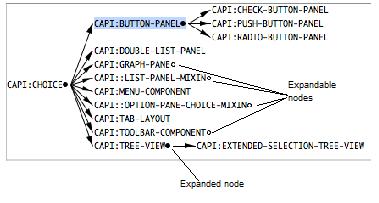





6.3 Expanding and collapsing graphs
You may often find that you are only interested in certain nodes of a graph. Other nodes may be of no interest and it is useful, especially in large graphs, to be able to remove their children from the display.
Notice that some nodes have a small circle drawn alongside them, as shown in Expanded and expandable nodes. The circle indicates that the node is not a leaf node, that is, it has children. Moreover, the circle is filled black if the node is currently expanded, and is unfilled if the node is currently expandable (also referred to as collapsed).
6.3.1 Expanding and collapsing by clicking
To collapse or expand any node with children in a graph, click on the circle alongside it. Thus, click on the unfilled circle of an expandable node to display its children, and click on the filled circle of an expanded node to hide its children.
Figure 6.2 Expanded and expandable nodes
For instance, in Expanded and expandable nodes, click on the unfilled circle alongside CAPI:TOOLBAR-COMPONENT to display its subclasses. Click on the filled circle to hide them.
6.3.2 Expanding and collapsing by menu commands
You can also collapse or expand nodes using the context menu:
-
Choose
Expand Nodes
to expand the selected node.
-
Choose
Collapse Nodes
to collapse the selected node.
LispWorks IDE User Guide (Unix version) - 13 Sep 2017













